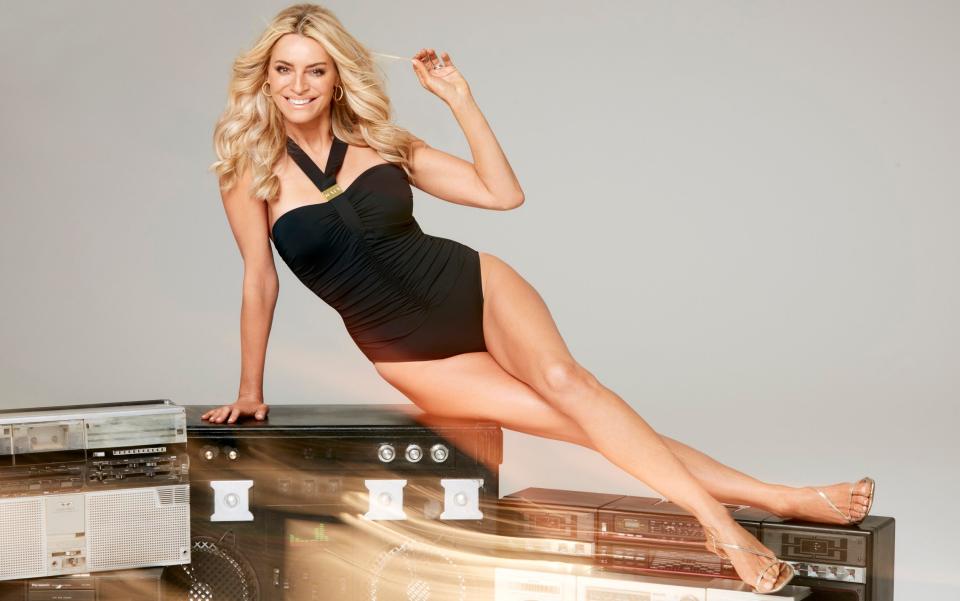How does Tess Daly look this good at 51?

Midlife is typically a time when our metabolism seems to grind to a halt and along with it our efforts to lose weight. Throw in a pandemic, and with it the triple load of work, childcare, home schooling, and perhaps aging parents and other life responsibilities, it is little wonder that many midlifers have let things slide since the start of this year.
Not so Tess Daly, who this month graces the cover of Women’s Health magazine at 51, and told the publication: “I’m in my fifties now. That’s still a shock when I say it out loud, because I don’t feel any different to when I was in my thirties.”
She doesn’t look it, either. Daly is one of a growing number of midlife “fit-fluencers” (Davina McCall, 53, Helena Christensen, 52, and Jennifer Aniston, 52, among them) who are redefining what it looks and feels like to be 50-plus.
In the interview, Daly says that, “confidence comes from giving yourself some slack”. But there’s more to it that that: she does 20 minutes of YouTube yoga with Adriene Mishler every morning and evening, runs 5km on her home treadmill while watching Netflix and does interval training on Zoom with her personal trainer Sam Shaw, who takes her through a series of body weight movements, such as lunges, and core work.
Last month, Helena Christenson also sent Instagram into a frenzy after posting a photograph of herself walking in the snow wearing a pale pink bikini and has spoken of her love for wild swimming (which she puts down to her “Viking background and coming from a country which is relatively cold”), pole dancing and yoga, which she says help her stay in shape.
It’s not just women leading the way either. The likes of David Beckham and Gary Lineker have maintained their athletic bodies well into their forties without falling victim to the middle-aged spread that older former sportsmen used to deem as inevitable. Beckham includes handstands, triceps dips and running on a treadmill in a weighted vest among his lockdown workouts.
So how are these fifty-plusers bucking the midlife weight gain trend?
“From our thirties onwards, our bodies experience a drop in oestrogen levels in females and testosterone levels in males,” explains personal trainer Matt Roberts, 47. “At the same time, cortisol (the stress hormone) levels tend to get higher in both sexes, which has a knock on effect on how our bodies store energy and hold onto fat.
“By virtue of what’s happening in our lives – childcare, work stresses – we also tend to feel more tired and slow things down.”
He explains that due to a decline in testosterone levels, midlifers are more prone to muscular aches, joint pain and a slower metabolism. It’s also the reason they develop a wider midsection, seemingly out of nowhere, that’s hard to shift. “This is a result of visceral fat, which is the fat that sits deep inside and around the internal organs and it’s what leads to obesity and a greater risk of cardiovascular disease.”
However, as the likes of Daly and Beckham show, we can slow down our fitness age by adapting our workouts as we get older. As we enter midlife, Roberts explains we should be exercising in a way that preserves “flexibility, strength and stability” and maintains hormone levels.
Roberts cites Daly’s example of daily yoga, to reduce cortisol levels, and how she shuns sweaty gym workouts in favour of gentler exercises, such as body weight movements and trampolining. Christenson echoes this, saying her love of yoga only came about in middle age and how she has swapped long runs for shorter ones.
Roberts explains that stretching and dynamic mobility exercises, like yoga and Pilates, are “critical additions” to midlife exercise routines, because they improve the range of motion around the joints, leading to greater flexibility, which leads us to be more active.
Doug Robertson, founder of Balance Training, agrees. Daly used to follow Robertson’s “Perfect Bum Technique”, which uses Pilates to sculpt the buttocks and thighs. “When you look at someone like Tess, you can see she has got vitality. Yoga and Pilates help with digestion, breathing patterns and flexibility, which is what everyone needs at that age,” says Robertson.
However, it isn’t all about low intensity workouts. Roberts says that while cardiovascular fitness doesn’t decline much with age (about five per cent over a 20-30 year period), muscle mass does: women lose eight per cent of muscle a decade after 40. To combat this, resistance and strength training are crucial.
“You’ve got to have something that stresses your muscles to the right degree and gives you a skeletal, structural overload to allow good postural positioning,” says Roberts. “By overloading the muscles, you are also creating the biggest growth hormone response.” One way to do this is through supersets, where you work opposing muscle groups, for example ten biceps curls followed by ten triceps extensions. This also helps strengthen bones, which become less dense as we get older.
Read the full Tess Daly interview in the April issue of Women’s Health UK, on sale from 3rd March



